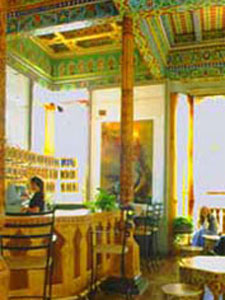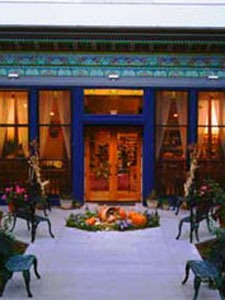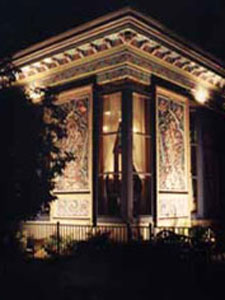Teahouse Reviews: The Dushanbe Teahouse



The Dushanbe Teahouse 1770 13th Street, Boulder, CO 80302 Phone (303) 442-4993 Afternoon tea daily from 3 to 5 pm Formal Afternoon Tea served Tuesdays, 3 to 5 pm Lunches and dinners served Mon to Fri brunch and dinner weekends
Boulder, Colorado, earned a top spot on the tea drinker's travel destination map in May 1998 with the reconstruction of a teahouse from the central Asian city of Dushanbe in Tajikistan. Located just blocks from town shopping, across the street form the city's Central Park, the stunning teahouse is a jewel on the silk road of good will between these two sister cities.
The Teahouse is a masterful display of Tajik artistry stemming from the Persian and Islamic roots of the Tajik craftsmen who made it as part of the two cities' ongoing cross-cultural exchanges. The Western Hemisphere's only Tajik teahouse was built in Dushanbe and shipped to Boulder.
The Teahouse is both striking and serene. Its symmetrical facade of central, double wood doors surrounded by large paned windows framed in bright blue, gives way at the ends to carved and painted ceramic panels in highly vivid blue, yellow, green, white, and red patterns. Across the top of the Teahouse stretch colorful cascading bands of carved and painted wood, which simulate the multiple borders of a Persian carpet.
The intricate, abstract decoration continues inside where it enlivens the walls and ceiling. Carved white plaster wall panels frame contem-porary paintings by a Tajik artist while Persian carpets add color to the floor. Guests can choose to sit in chairs at regular tables or to sit cross-legged at topchans, low cushioned plat-forms topped with short-legged tables.
The convivial at-mosphere of the Tea-house revolves around a vernal garden and pool with seven bronze female statues representing the "Seven Beauties" from the poem of that name written by the great Persian poet Nizami Ganjavi. Carved, red cedar pillars supporting a rectangular vault, which is lit by recessed lights and a large skylight, further punctuate this inner courtyard. A tea and coffee bar nestle into the back right corner.
In Tajikistan, teahouses are centers of hospitality, easily found near bazaars or by listening for music coming from them onto the street. People (mostly men) meet there for green tea, food, conversation, and chess. The Boulder Dushanbe Teahouse offers dishes from Persia and more than seven other countries with uncompromising quality.
Tea drinkers will appreciate the generous selection of full-leaf, handpicked teas that are served in a Chatsford pot. The waitperson will tell you how long to steep your tea before removing the infuser to the accom-panying dish. Particularly recommended are the Ti Kuan Yin and Golden Monkey Yunnan. Reservations are encouraged for the formal Afternoon Tea on Tuesdays, when the tables are covered with white linens. The menu offers tea sandwiches, pastries and sweets, scones with cream and lemon curd, and a choice of three traditional blend teas. All teas are available for bulk purchase.
How lucky is Boulder to sport this Central Asian gem? Consider this from The Oxford Companion to Art: "Persian art retained its vitality and originality until... (1736). Thereafter political instability and a surrender to the spell of European art vitiated the national creative spirit... Lack of a definite orientation was accom-panied by a steady decline in craftsman-ship. Nor in the first half of the 20th century had there yet appeared any trends significant of a renaissance in the arts."
This is not to say that Persian art came to a complete halt after 1736, for many of the forty or so artisans who contributed to the Teahouse acquired their talents from family members who passed the skills down through the generations. But add Tajikistan's history in the latter part of this century to the overall decline in Persian art since the Middle Ages, and the fortune embodied in the Teahouse, financial and otherwise, becomes even more remarkable.
The mayor of Dushanbe announced the Teahouse gift in 1987, the year the sister cities were established, when Tajikistan was still part of the U.S.S.R. The Teahouse was shipped to Boulder three years later. Tajikistan became an independent country just one year later, beginning a period of increased ethnic tensions, a civil war, and a failing economy that has orphaned tens of thousands of children. According to a United Nations' report, 50 percent of the population now is living in poverty. Had the Teahouse not so graciously been given when it was, there is perhaps little or no chance that the project would blossom any time in the foreseeable future.
Between the ornate Tajik surroundings and the tastefully prepared food and drinks, the Boulder Dushanbe Teahouse is a memorable spot you will want to revisit: the Tajiks who crafted the Teahouse, the National Endowment for the Arts (which contributed $25,000 for reconstruction of the teahouse in Boulder), the Boulder-Dushanbe Sister Cities organization, the chefs, and the restaurant operators see to it. If you are going to be anywhere in the area, make a pilgrimage to Boulder to pay homage to this special tea treasure.
